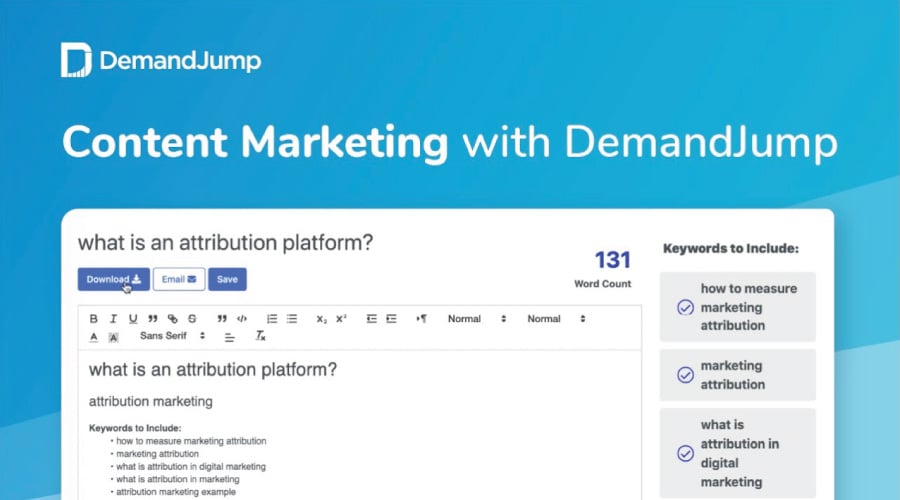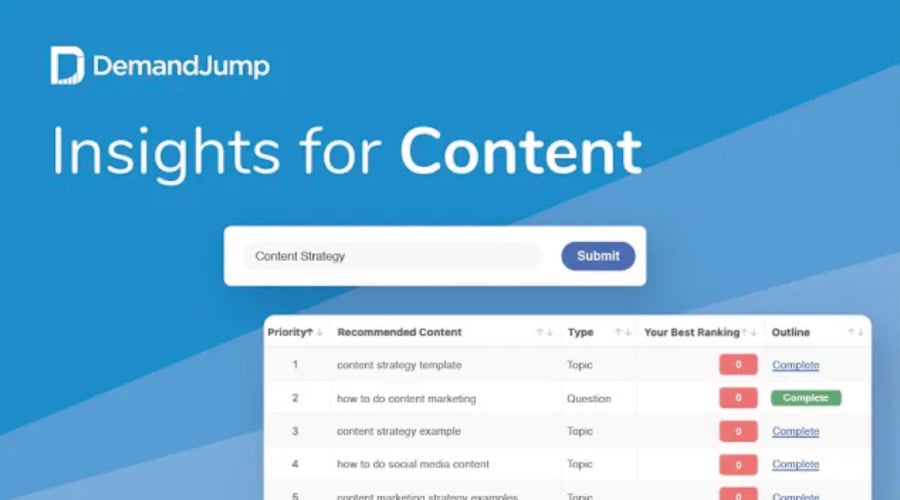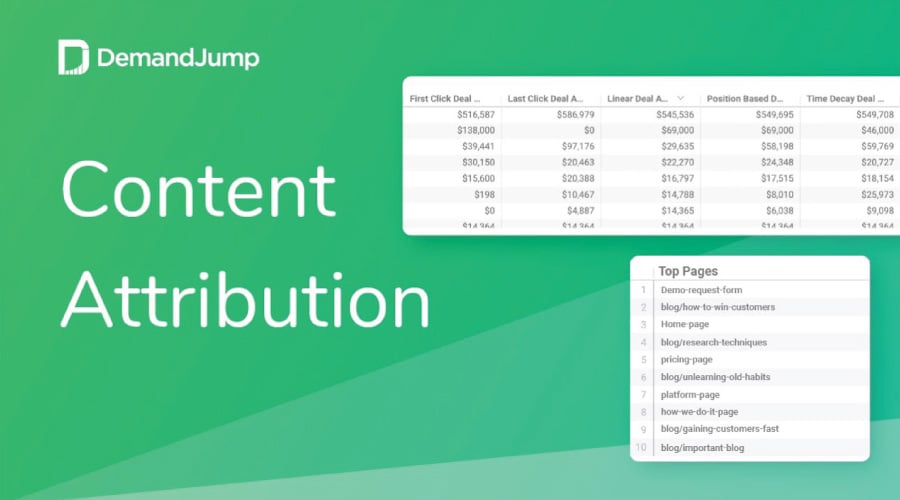If you’re in search of an SEO strategy, today’s your lucky day! Developing an SEO strategy in 2023 and beyond might seem like a whole new game—especially with AI tools like ChatGPT on the rise. But rest assured, the rules haven’t changed much. We at DemandJump have compiled some resources to help you form an SEO plan, including definitions, examples, and a downloadable PDF checklist. And for your convenience, we’ve split this article into five sections:
- Part 1: What Is SEO, Really?
- Part 2: What Are the Four Types of SEO?
- Part 3: How Do I Create an SEO Content Plan?
- Part 4: Examples of SEO in Digital Marketing
- Part 5: SEO Strategy Template (Free Download)
With that, let’s just jump right into it. After all, page one is waiting!
Part 1: What Is SEO, Really?
You may know that SEO stands for “search engine optimization,” which is formulating your content and website components to increase web traffic. You may also know that SEO is not a simple goal. Why is this the case? Well, for starters, SEO is a moving target, and it moves often (technically, it’s always moving). Whether or not your content is “optimized” for search engines depends on a lot of factors, several of which are in constant flux. This includes:
- What people search for online (which DemandJump observes through our Insights tool)
- How search engines are prioritizing which content they share
- Whether your website is well-organized, indexed, and mobile-friendly
- If you are writing good content (which DemandJump can help with!)
As you can see, SEO is not just one seed coming to fruition, but multiple cogs in sync, turning towards a common goal. That goal is your target audience. So, to know what “SEO” means for your brand, you must know who you’re trying to reach, what those people want, and how you’re going to give it to them. Easy, right?
We know—easier said than done.
Thankfully, it’s something you can achieve—especially if you have a plan. A good starting point is breaking your strategy down by the multiple types of SEO, all of which require different approaches.
Part 2: What Are the Four Types of SEO?
SEO can be divided into four categories:
- On-Page SEO
- Off-Page SEO
- Technical SEO
- Local SEO
Each of these relates to different pieces of your web content, and how its digital footprint helps (or harms) your chances of getting it in front of your target audience. Let’s take a closer look.
On-Page SEO
As the name suggests, everything on your actual webpage contributes to on-page SEO. Most people think of keywords, but on-page SEO is about much more than finding the right keyword density. You also need to consider technical components, such as meta-tags, image alt text, and even the title.
On-page SEO is how search engines determine whether or not your content is related to a web user’s query. This, among other reasons, is why it’s important to write good content for your brand. For our purposes, “good” content means it is:
- Helpful
- Original
- Engaging
We’ll take a more detailed look at each of these traits in Part 3 (How Do I Create an SEO Plan?).
Off-Page SEO
Improving what’s on your webpage is not the only way to increase traffic. Off-page SEO focuses on all of the ways people find you through other people’s content—or in some cases, content you place on other platforms, like LinkedIn, Twitter, or other social media. Essentially, the more people are talking about your brand and referencing it online, the better your off-page SEO will be.
There are many ways to improve off-page SEO, but here are some ideas to get your brain going:
- Press Releases | Simple but effective, this involves producing an official written statement that you then give to the news outlets of your choice. With this, though, keep in mind that people receive their news through a variety of outlets, from television to social media and even podcasts. You’re not just limited to the New York Times!
- Brand Collaborations | Every time you work with another organization on content, you both benefit from exposure to each other’s target audiences. Guest blogs, joint projects, or even appearing on other brands’ media (like podcasts) are ways to boost your off-page SEO.
- Social Media Marketing | Don’t worry—you don’t have to become a TikTok star. There are many ways to use social media, as well as multiple social media platforms. Of course, you have the usual suspects like Instagram, Facebook, Twitter, and LinkedIn, but depending on who your audience is, they may have a niche platform dedicated to their common interest. If that interest lines up with what you do, then you’re in the right place!
Technical SEO
“The devil is in the details,” as they say. If you want to understand why technical SEO matters, think of all the times you’ve been on a website that loads slowly, has a lot of bugs, or is laid out poorly. This goes double for content that isn’t mobile friendly, since over 90 percent of web surfers are scrolling on a phone.
Technical SEO is all about making your website as easy to navigate as possible for both people and the crawlers, which are bots that explore web pages to learn about their content. A sensical site layout obviously helps human readers, but it also helps bot readers—particularly as they determine how to sort, store, and index your webpage for future reference. There is some overlap between technical SEO and on-page SEO. Take image alt text, for example: not only does it help your content show up in search results (on-page SEO), alt text also helps someone with a visual impairment navigate your content (technical SEO).
Local SEO
Everyone loves a hometown hero, right? Local SEO is best summarized with two words: “near me.” Even if your brand is primarily digital, it still pays dividends to win out search results in a geographic area. Local SEO boosters like a Google My Business profile not only help you nab those “near me” searches, they make it easier for people to learn about your brand. This includes operating hours, websites, contact information, or anything people need to connect with you. Good customer reviews help, too!
As you make your SEO strategy, be sure you’re accounting for each of these four types of SEO. They all impact your content’s performance in different ways. If that seems like a lot, don’t worry—we’ve included a shorthand checklist for you in Part 5 (SEO Strategy Template).
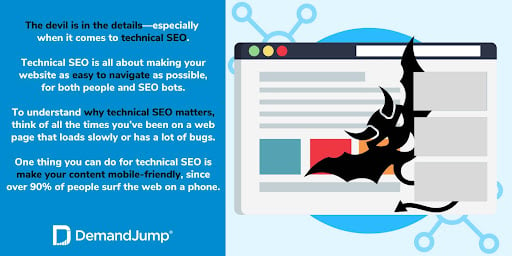
Part 3: How Do I Create an SEO Content Plan?
Once you’ve performed a website audit and developed strategies for each of the four SEO types, it’s time to focus on your content. Creating good content is the heart, soul, and driving force of your SEO strategy. If your SEO plan is the chariot you use to ride through the digital landscape, then your content is what’s pulling the reins. And what would you rather have pulling your chariot: a stubborn mule, or a glorious pegasus? Which will get you to where you’re going faster? (Here’s a hint: one of those can fly.)
Good content makes all of the SEO work matter because compelling content connects you with your consumers much easier. Honestly, without a strong message, the other details don’t matter nearly as much, so be sure not to put the cart before the pegasus. After all, only one of them can move on its own.
What Is Considered Good Content?
For what you produce to truly have value, it must be three things:
- Helpful | Possibly the most important part, you need to give the reader something they’re searching for—whether that’s information, resources, or say, an SEO strategy. On-page SEO ensures that search engines understand that your content is helpful to people.
- Engaging | While not everything you produce has to go viral, grabbing your reader’s attention is still important. People may find (and even read) your work if it solely gives them the information they wanted, but engagement is how you get them to come back. Readers are best engaged when they hear language they understand, topics they relate to, and actionable items. This is why DemandJump’s Consumer Insights tool is so useful for writing content—because it collects keywords that people are actually typing in search engines, right then and there. You’ll know not just what your customers are looking for, but what language they’re using to find it.
- Original | Okay, this may actually be the most important part. The thing is, even if your content is helpful and engaging, if you are repetitive, or worse—copying other brands’ work—people will know. And even if they don’t pick up on it, Google certainly will. There are no shortcuts to producing content that will pay off in the long run, so be sure to focus on doing what you do best. After all, if you make things that only you can produce, it’s much easier to stand out!
Good content needs to be all three of these things, all at once. Some can skate by momentarily with two or maybe even one of these traits, and trust us, some certainly try. But the SEO game is more akin to chess than checkers. Only worthwhile content—work that is helpful, engaging, and original—pays off.
- AI content can occasionally be helpful, but it’s rarely engaging and never is original.
- Keyword stuffing can technically be original content, but it’s definitely not engaging or helpful.
- Copying others’ content is…well, do we even have to say why that’s not good?
Can I Do SEO on My Own?
While you certainly can, it’s likely not the best idea—especially if you want results. SEO is complex, so much so that specialists sometimes focus on just one type of SEO. Unless you have a lot of experience or in-house expertise, it’s best to get some help. This is not to say that you can’t do some of the components on your own, but it’s always better to have an outside perspective, particularly if they understand good SEO techniques and tools. And if it’s good written content you’re missing, DemandJump can help you produce content that is not only compelling, but catered directly to your audience’s search behaviors. (More on that later.)

Part 4: Examples of SEO in Digital Marketing
SEO strategies have diversified greatly, meaning there are many ways to reach the same end goal. To illustrate this, let’s apply some SEO best practices to a hypothetical business—focusing on each type of SEO individually.
Clare is a businesswoman who wants to start a music store in her Chicago neighborhood, selling vinyls, CDs, cassettes, and other music-related products. While Clare hopes all sorts of music-lovers buy from her shop, she primarily wants to focus on serious collectors in search of more obscure records. As such, her store’s website doubles as a blog where she and her employees regularly review music.
Clare knows her target market (music collectors), what they want (obscure records), and how she’s going to fill their need (in-person and online sales). So, as she creates content for her website, how can Clare use SEO marketing techniques to her advantage?
To answer this, let’s break things down into each SEO type:
- On-page SEO for Clare will be all about writing reviews that her target audience will care about, and building their trust in her brand’s tastemaking skills. To do this, her content must be consistently good—that is, helpful, engaging, and original. Clare can accomplish this by:
- Doing keyword research to see what music is trending, using a tool like DemandJump’s Consumer Insights platform
- Writing good meta data, and using relevant images with appropriate alt text
- Offering her unique, authentic perspective—even if it contradicts popular opinions
- For off-page SEO, Clare wants to focus on as much cross-promotion as possible, particularly in her local Chicago music scene. She plans on doing this by:
- Making guest appearances on her local radio station, reviewing shows and music projects
- Writing for other music blogs, making sure to cite her business in the byline
- Starting an employee-run TikTok where her staff posts fun videos about their day-to-day
- Technical SEO is something that Clare knows little about, so she decides to hire a technical SEO specialist for support. After working with a specialist, she’s able to:
- Optimize her site for mobile viewing
- Submit her most popular blog posts for Google Indexing
- Decrease the image sizes on her page so it loads faster
- Local SEO is partially covered by Clare appearing on regional radio stations, but her work here is still not done. As finishing touches, she wants to:
- Create a Google My Business page for her store
- Confirm that her store hours and contact information are up to date
- Incentivize customers to post online reviews about her store
Sounds like Clare has a pretty solid game plan for SEO! We’ll surely be seeing her in our search results.
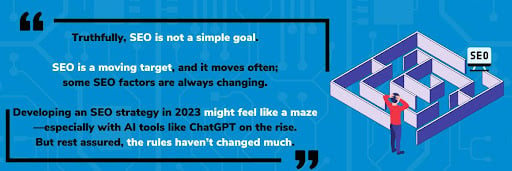
Part 5: SEO Strategy Template
Here it is: your guidelines for SEO success! Below is a list of questions and suggestions that will help you get on track with each part of an excellent SEO strategy. Keep in mind, these are not hard rules, but ways to jumpstart your thinking around SEO. Use this list as a way to start a new strategy, refine it, or check in as your brand (and content) evolve:
On-Page SEO
- Are you creating good content (helpful, original, engaging) for your target audience?
- Does your content use keywords that relate to what your audience is searching for?
- Have you written appropriate meta-data (alt text, meta tags, etc.)?
- How are your pages ranking? Have their positions changed? If so, what direction are they going?
Off-Page SEO
- How will people who are not actively searching for your content find you?
- Do you have a presence on other websites and platforms besides your own?
- Are you collaborating with other brands or organizations?
- Who are you telling when you have a new project or initiative in the works—and how?
Technical SEO
- Is your website optimized for mobile devices?
- Have you indexed your content on Google?
- Does your site have bugs or issues with loading properly?
- How fast does your site load?
Local SEO
- Is your basic information updated and consistent? (Business hours, contact, URLs, location, etc.)
- Are people leaving (positive) reviews about your brand?
DemandJump Is the Name, Content Is the Game
If you’re creating an SEO plan for your organization, you need to have content that is compelling, well-written, and tailor-made for your consumers. DemandJump knows the best ways to get your brand in front of people, thanks to our Pillar Based Marketing (PBM) strategy. We use real search data to determine what keywords are trending around your topics, then craft content Pillars that will keep your audience coming back for more.
When you’re ready to level up your SEO game, reach out to us or try a free demo of our platform!




